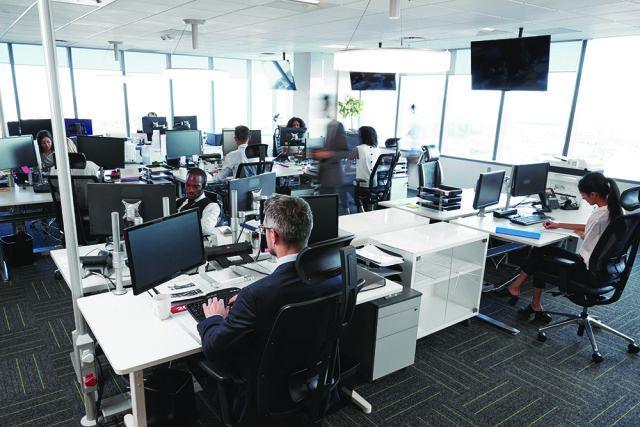Inside out

While pollution levels in our air are a major cause for concern, Mitsubishi Electric Product Manager Hern Yau explains why we need to be cautious about assuming indoor air is always better.
The British Heart Foundation’s campaign to raise awareness of the dangers of air pollution is hard hitting. It makes a clear link between toxic particles in the air and an increased risk of heart attack and stroke. The BHF is demanding changes in the law to protect the nation’s health.
Reducing pollution outdoors has to be a good move for all of us. But it’s important to remember that as humans in a developed part of the world, we spend much more of our time indoors – mainly at home or at work. Can we breathe easier indoors?
Unfortunately, it seems the answer is ‘not necessarily’. If you work in an office in a busy city, you might question the wisdom of opening windows to let in air. There is an instinct that says, keeping the windows closed keeps the pollution out. But the air in our workplaces isn’t necessarily as clean as people might assume.
And the issue isn’t simply about the quality of air we are bringing air into a building. Paint, furniture, printers, photocopiers – all of the usual office equipment actually generates harmful chemicals known as volatile organic compounds (VOCs)
What’s more, buildings need to be cleaned which often includes using chemical sprays. This can be especially problematic if a building is cleaned afterhours when the ventilation system is shut down to save energy, where those chemicals will linger. This can be particularly harmful for those using the cleaning chemicals and people working out of normal office operating hours. Think, if you wouldn’t ingest a cleaning substance, breathing it in is no better for you.
Indoor air is a mix which includes the air from outdoors too – a double whammy for the health of occupants. So the challenge is as much about getting the ‘polluted’ air out of the building.
The impact of external air on building occupants is considered at the planning stage for new buildings. Assessments are made that measure air quality close to a proposed building over a certain amount of time. The results are used by planners to require, for example NOx and particulate matter filters, to bring air quality levels inside the building to acceptable levels.
But the ongoing assessment of IAQ is more of a challenge. The built environment changes. A building that was once near open space, may eventually see a road constructed nearby – or traffic may increase because of changing road use over time. There is often no future analysis to check if your air quality inside is still acceptable. If it was deemed appropriate at the planning stage simply to have openable windows as the ventilation strategy, then there are clearly going to be issues with what’s coming into the building from outside.
These issues have been exacerbated by the focus on air tightness in Part L of the Building Regulations. While energy efficiency in buildings is very important, cutting down ‘leakage’ of air has put greater emphasis on the need to design ventilation systems to support good indoor air quality.
Natural ventilation is also an option. It is a solution that relies on specialist design to harness natural air currents. It offers energy saving benefits and can be a good approach for new buildings. However, for existing buildings it is a more challenging method to adopt, and the effectiveness of harnessing natural air currents can be affected if structures around a building change.
The message here is that when making decisions at the design stage of a new build or a refurbishment, it is important not to focus too much on one issue, but to take a holistic approach to considering options for ventilation.
Mechanical ventilation uses more energy to move air than relying on natural air currents. However, it offers a more predictable and reliable way to move air into (and out of) a building. Designers and their clients need to weigh up the options.
One way to mitigate against the energy use of the mechanical ventilation is to use demand control so that ventilation only works when it is required. There are a number of sensors on the market today that can not only help demand control, but they can also track IAQ and help FMs spot any unwanted drops in IAQ.
Using CO2 sensors, for example, is a good way to also measure occupancy (since humans produce CO2). A sensor in a meeting room can ensure that the mechanical ventilation reacts to a full room, but power down the fans when the room is empty. Not only does this improve the indoor environment for occupants, it also reduces energy use and saves on fan wear-and-tear.

Due to recent changes in the law on refrigerants, many building owners are taking a close look at their air conditioning systems. This could also be a good time to consider ventilation methods. It’s particularly important if the building hasn’t had air conditioning in the past. As our UK summers reach higher temperatures, businesses are looking to support staff comfort and productivity by introducing air conditioning to the building.
It’s a good solution, but if in the past the ventilation strategy has been ‘open the windows’ adding air conditioning could cause issues with air quality. Air con 101 says that you keep your windows closed when conditioning is underway or you will waste energy. However, by closing those windows you have shut off your only means of ventilation. Occupants might be cooler, but they could also be showing signs of the effects of poor IAQ such as headaches and more sickness. So it’s sensible to consider the conditioning and ventilation in tandem.
Again, the demand control approach can save energy, money and provide better performance. Leading manufacturers will provide equipment that includes simple timers, giving building manager further opportunity to ensure that cooling and ventilation are off when they’re not required.
Mechanical ventilation with heat recovery (MVHR) is another effective means to ensure that conditioning and ventilation work hand-in-hand in an energy efficient way. With MVHR, as stale air is extracted from a building, up to 80% of the temperature of the outgoing air is recovered and transferred to the incoming fresh air, keeping the building at a comfortable temperature and helping reduce overall energy costs. It works equally well in winter and summer.
For example, if the indoor air is 21°C, but the outdoor air is 27°C, then any incoming air needs to be cooled down to 21°C, which means the air conditioning needs to work harder and consume more energy.
With MVHR though, the incoming air passes over the cooler, outgoing air, to reduce the 27oC temperature to around 22.3oC. By transferring heat to the cooler outgoing air. This incoming air therefore needs less energy to bring it down to the desired temperature of 21oC, saving energy.
Another benefit is that MVHR systems deliver controlled ventilation into a building through slow but constant air movement. This has an advantage over natural ventilation which delivers uncontrolled and sometimes unreliable air flows. A steady stream of indoor air is extracted and replaced with fresh air, rather than in ebbs and flows. By delivering a controlled air flow path throughout a building, all occupants can benefit from the improved air quality, rather than those sitting by trickle vents or the open window.
Heat recovery can also work as part of a demand-control system. For example, the Mitsubishi Electric Lossnay MVHR range can be linked to CO2 sensors (or any other sensor that’s required) to operate on a demand control basis – increasing potential energy savings further.
The importance of improving our outdoor air quality should not be underestimated. The UK government has a long way to go on improving it’s approach to this issue. But cleaning up outside will only take us so far. Our outdoor air could be spotless, but our buildings still need to be refreshed because we generate pollutants indoors. We can’t assume that if the external air is clean, the inside will the fine. Ventilation is key to IAQ and shouldn’t be left to chance.
All of this applies in our homes too. The National Institute of Clinical Excellence released its guidance on IAQ in homes in January 2020 (Guideline NG149). It cites poor IAQ as a source of many common illnesses and conditions. One of its important points is that heating and ventilating systems should be designed with a whole building approach “balancing indoor air quality with standards for energy use.” This is equally good advice for commercial buildings.
Hern Yau is product manager at Mitsubishi Electric Living Environmental Systems
Picture credit of office workers: iStock.com/monkeybusinessimages
Picture credit of main picture: Shutterstock.com/Preechar Bowonkitwanchai







